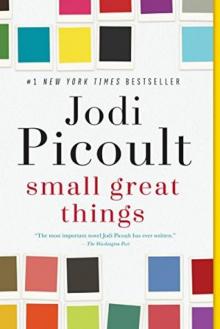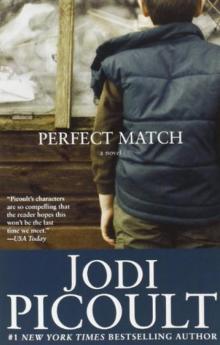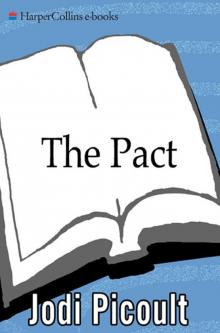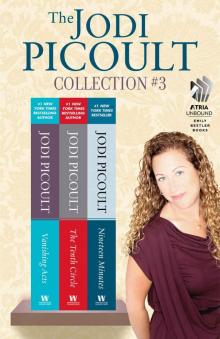- Home
- Jodi Picoult
The Book of Two Ways Page 2
The Book of Two Ways Read online
Page 2
One of the questions I ask my clients is What’s left unfinished? What is it that you haven’t done yet, that you need to do before you leave this life? I’ve heard nearly every response: from fixing the front door where it sticks to bathing in the Red Sea; from publishing a memoir to playing a hand of poker with a friend you haven’t seen in years. For me, it’s this. This dust, this tooth-jarring ride, this bone-bleached ribbon of landscape.
In a previous life, I had been planning to be an Egyptologist. I fell in love with the culture first, when we studied Ancient Egypt in fourth grade. I remember standing at the top of the jungle gym and feeling the wind and pretending that I was in a felluca, crossing the Nile. My prized possession was a guidebook from the Tut: Treasures of the Golden Pharaoh exhibit that my mother had found at a secondhand bookshop. In high school, I took French and German, because I knew that I would need those languages to translate research. I applied to colleges that offered Egyptology programs, and studied on full scholarship at U Chicago.
Most of what I learned about Ancient Egypt can be boiled down to two subjects. The first is historical—Egypt was ruled by thirty-two dynasties of pharaohs, split across three main time periods: the Old Kingdom, the Middle Kingdom, and the New Kingdom. The First Dynasty began with King Narmer, the pharaoh who unified Upper and Lower Egypt around 3100 B.C.E. The Old Kingdom is best known for being the time the pyramids were built as tombs for the kings. But around 2150 B.C.E., civil war broke out in Egypt. There were forty-two separate territories—or nomes—each headed by a nomarch. During this period, each nomarch was fighting for his own nome. There were alliances, but the pharaoh in the north didn’t rule over a unified Egypt; instead, it was like the Egyptian Game of Thrones. The Middle Kingdom began when a king named Mentuhotep II reunified Upper and Lower Egypt around 2010 B.C.E. That lasted until the Hyksos invaded from the north and a period followed where rulers were from foreign lands. It wasn’t until King Ahmose crushed the Hyksos that Egypt was reunited again during the New Kingdom, in 1550 B.C.E.
The second key subject involves Ancient Egyptian religion. Much of it was related to the sun god, Re—who, as the sun, was pulled across the sky daily in a long boat called the solar bark—and Osiris, the god of the Netherworld. Osiris was also the corpse of the sun god, and so they were flip sides of the same coin. This was not a logic bomb for the Ancient Egyptians because Osiris and Re were simply two faces of the same entity, like the Christian trinity of the Father, Son, and Holy Ghost. Every night, Re visited Osiris and reunited with his corpse, which powered him up to make the sun rise the next day. The Egyptian model of the afterlife imitated this cycle: the deceased’s soul was reborn daily like Re, and reunited nightly with its corpse.
A lot of what we know about Ancient Egypt comes from tombs, so we have proof that great pains were taken to prepare for dying, and what came afterward. Even people who don’t know much about Egyptology have heard of the Book of the Dead—or, as Ancient Egyptians called it, the Book of Going Forth by Day. It’s a New Kingdom collection of spells to help the deceased make his or her way to the afterlife—but it evolved from earlier, lesser known funerary texts. First came the Old Kingdom’s Pyramid Texts: spells to ward off evil creatures, words to be spoken at funerary rituals by the dead king’s son, and instructions for the deceased to reach the next world. By the Middle Kingdom, funerary texts were found painted on the coffins of nobles and other citizens, including spells to restore family relationships, because death can separate us from people we love; spells to help the deceased travel with Re in his solar bark to defeat Apep—the serpent of chaos—who tried to suck the water out from underneath; and spells to help the deceased become one again with Osiris every night.
Also part of these Coffin Texts was the Book of Two Ways, the first known map of the afterlife. It was found only in certain coffins in Middle Egypt during the Middle Kingdom, usually painted on the bottom. It showed two roads snaking through Osiris’s realm of the dead: a land route, black, and a water route, blue, which are separated by a lake of fire. If you follow the map, it’s like choosing between taking the ferry or driving around—both ways wind up in the same place: the Field of Offerings, where the deceased can feast with Osiris for eternity. There is a catch, though—some of the paths lead nowhere. Others push you toward demons or circles of fire. Embedded in the text is the magic you need to get past the guardians of the gates.
The first passage I ever translated from the Book of Two Ways was Spell 1130: As for any man who knows this spell, he will be like Re in the sky, like Osiris in the Netherworld, and into the circle of fire he will descend, but no flame will be against him forever and ever.
Forever and ever. Neheh djet. Time, for Ancient Egyptians, moved differently. It could be linear and eternal, like Osiris. Or it could be cyclical, with daily reincarnations, like Re. These were not mutually exclusive. In fact, to have a good death, you couldn’t have one without the other. The tomb was the connective tissue, the magical battery that provided the juice for eternal life. Most Egyptologists studied the images and hieroglyphs in a vacuum, but as a young academic, I started to think about their placement in the coffin, and the Book of Two Ways on the floor. What if the mummy inside was meant to activate the magic, like a key?
The versions of the Book of Two Ways that have been published have come almost exclusively from coffins of nomarchs from the necropolis at Deir el-Bersha, a sprawling collection of rock-cut tombs of nobles, a city of the dead. Fifteen years ago, I was a graduate student working in those tombs, trying to prove my thesis.
What’s left unfinished?
As the driver turns south, bringing me back to Deir el-Bersha, I glance out the window again, struck by the beauty of the sky yawning over the desert. It’s blue and pink and orange, the stripes of a day that’s only beginning. A star winks at me for a moment before it’s swallowed by the sun.
Sirius. I’ve arrived in Egypt the day of the Sothic rising.
Because Egypt is a valley, you can see stars there like nowhere else, and the Ancient Egyptians tracked the rise of groups of stars in their solar calendar. Every ten days, a new group of stars would appear in the east at dawn, after being absent for seventy days. The most important of these was the star Sirius—which they called Sothis, or Sopdet. The Sothic rising signaled rebirth, because it occurred in the season when the Nile would flood and leave silt to fertilize their crops. To celebrate, Ancient Egyptians would travel to festivals, often leaving graffiti where they went. But mostly, they would get drunk and have sex—it was like Coachella, every time the Nile overflowed.
Wyatt once told me that at these festivals, the Ancient Egyptians would purposely drink to the point of vomiting, so that they imitated the Nile flood. Those Egyptians, he said, knew how to live.
I look up at the sky again, searching for Sothis. Just like the Ancient Egyptians, I see it as a sign.
* * *
—
DEIR EL-BERSHA IS located smack in the middle of Egypt, opposite the town of Mallawi on the east bank of the Nile. Only people authorized by the government are allowed entry because of damage from ancient earthquakes and recent lootings.
I stare at the scenery until I see the familiar rock-cut tombs. Dozens of tiny metal doors are lined up in a striated row of limestone, like a hotel carved into the walls of the wadi, the valley. A death hotel. I can pick out exactly where I spent three seasons in the tomb of Djehutyhotep II, the overlord of the Hare nome. Below it, covered with staging, is the newest tomb. I squint, but I can’t see any activity there.
That’s not the only thing that’s new in Bersha. There are sprawling modern cemeteries that didn’t exist in 2003, just a little south of the tombs. Beside a mosque, there is now a brightly painted church for Coptic Christians. Along the banks of the Nile, Egyptian farmers walk on narrow raised paths between their fields, or heap the flat fans of date palms into a donkey cart. And then suddenly, we are at the
Dig House. I pay the driver and step out of the taxi, sand flying up around me.
The house has changed, too.
It was built out of mud brick in 1908 by a British architect, Gerald Hay-Smythe, to match medieval Coptic monasteries. The porch had collapsed before I arrived as a grad student, and no one ever got around to fixing it. But now, I see, the porch has been rebuilt.
There are no vehicles parked outside, and there’s a stillness to the house that speaks of emptiness. I walk past a patch of wild onions and a rusting bicycle into the outer courtyard. Sheets and shirts and galabeyas, the long caftan garments worn by locals, hang on crossed clotheslines. Fifteen years ago, the Egyptian family who looked after the Dig House and the Egyptologists inside it would string our laundry up like this. All our bedding smelled like sunlight.
“Hello?” I call out. There isn’t a door to knock on, just an open archway. Hesitantly, I step forward, and startle a cat. It yowls and leaps onto a crumbling sill, where it judges me with narrow eyes before disappearing inside the open window.
I walk down the long corridor that separates the quarters of the local caretakers from those of the archaeological team. A fine layer of grit covers the floor, the walls, everything. “Is anyone home?” I say, but the only sound is swing music crackling from a speaker in the throat of the house. I peek my head into a room without a door, which has a stack of old twin mattresses printed with the Disneyfied faces of Cinderella, Snow White, and Sleeping Beauty. Further down the hall is the entrance to the magazine—the storage facility where we would put any finds that we might want to look at during a future season. I can’t help myself from stepping through the doorframe, where in the dim light I scan neatly labeled cardboard boxes, stacked on shelves. Suddenly I whip around, certain I’m being watched. On a folding table is a mummy that was in this room long before I ever was, and will likely be here long after I leave. “George,” I murmur, calling him by the name everyone else had, fifteen years ago. “Good to see you again.”
Further down the hallway is the bathroom, an individual shower and a toilet. I use the facilities, fingering the frayed sign still taped to the back of the stall door: THINGS YOU SHOULDN’T FLUSH: ANYTHING YELLOW, TOILET PAPER, YOUR HOPES & DREAMS.
“Min hunak,” I hear, a voice getting closer. Who’s there?
I have literally been caught with my pants down. I spring up, wash my hands, and hurry out of the bathroom to try to explain myself, only to come face-to-face with a memory.
As if it were yesterday, I see this man with his weathered brown skin and gentle hands setting a platter of fresh salad in front of me at a table. He’s ageless, frozen in time, the same caretaker who looked after the house when I was a graduate student. “Hasib?” I ask.
His eyes widen, and hearing my accent, he switches to English. “Hasib was my father.”
I blink. “You’re…Harbi?”
Harbi had been a boy back then, though one of our best workers. He’d done whatever Professor Dumphries asked—from rigging staging so that we could scrutinize hieroglyphs at the top of the chamber wall to standing for hours in the hot sun with a mirror canted to capture the light so that we could accurately copy rock art.
His gaze narrows. “Dawn?”
“You remember me?” I say. If Harbi does, maybe he will not be the only one.
“Of course I do. You brought me Superman.”
Every time I flew through Heathrow, I’d pick up a comic book for Harbi and a Cadbury bar for Hasib. “I came empty-handed this time,” I confess. “Is your father still here?”
He shakes his head. “He died.”
Muslim clients of mine have always been better with death language than my Christian clients, who tend to be terrified of that transition. “I am so sorry to hear that,” I tell him. “I have many great memories of him.”
Harbi smiles. “As do I,” he says. “My son and I now see to the Dig House.” He frowns. “Mudir did not tell me you were coming.”
When I hear him say Mudir, the director, I immediately think of Dumphries, who had held that title as the head of the Yale Egyptology program. But of course, there is a new director now. Wyatt.
“It was sort of a last-minute decision,” I hedge. “Where is everyone?”
“It’s Friday,” Harbi says, shrugging. Fridays had been our days off, when we would often take trips to other dig sites. “They were visiting Sohag overnight.”
Sohag is another Yale archaeological mission, about three and a half hours south. “When will they be back?”
“Lunchtime, inshallah.”
“Would it be all right if I wait?” I ask.
“Yes, yes,” Harbi answers. “But you must be hungry, doctora.”
I feel my face color. “Oh,” I correct, “actually, I’m not. A doctora.” It makes sense for Harbi to assume that a visitor would be another Ph.D., like the ones from Yale, and that the girl who worked here for three seasons as a grad student would have completed her dissertation.
Harbi looks at me for a long moment expectantly. When I don’t say more, he starts walking down the hallway. “But you are still hungry,” he says.
I notice his limp and wonder what happened: if he fell on-site, if his injury pains him. But I can’t ask personal questions, not when I am unwilling to answer any myself.
“I’m not very hungry,” I say. “Don’t go to any trouble…”
Harbi ignores my comment and leads me to the largest room of the Dig House, which functions as a work space as well as a dining hall. “Please make yourself at home.” Leaving me behind, he shuffles toward the tiny kitchen, his rubber sandals scratching along the tile floor. Under the dome of mud brick is the same table where we ate all our meals, the wood still scarred and spotted. But it’s what’s different that takes my breath away. Gone are the rolled sheaves of Mylar and ragged stacks of manila folders and papers. Instead, a jigsaw puzzle of desks on the other side of the room is covered with computers—cables snaking like sea monsters and twined around each other, rigged into surge protectors that balance precariously, straining to reach a wall outlet. There are tablets charging and two impressive digital cameras. On the far wall is a giant printed rendering of the complete epigraphic copy of the colossus-hauling scene from Djehutyhotep’s tomb—the one that I had worked on with Wyatt that entire last season. I recognize the careful drawings I made with my own hand on Mylar, reproduced now in ink, with Wyatt’s translation in the margin. If I needed proof that I was once here, that I had done something worthy—it is literally right in front of me.
I step through the French doors onto the patio just as Harbi returns, balancing a stack of plates. “Please, sit,” he urges, and I slip into my old spot at the table.
He has brought a bowl of salad—chopped tomatoes, cilantro, and cucumbers—soft cheese, and aish shamsi, bread that is leavened in the sun before baking. I don’t realize I am starving until I start to eat and cannot stop. Harbi watches me, smiling. “Not hungry,” he says.
“A little,” I admit. Then I grin. “A lot.”
For dessert, he brings bas bousa—a mixture of coconut and honey and partially milled semolina. Finally, I sit back in my chair. “I think I may not eat for the next three days.”
“So then you are staying,” Harbi replies.
I can’t. I have a life halfway across the world, a family that is worried about me. But there is something so unreal about being back here, as if I’ve been able to simply rewind the clock, that makes this feel like I am just pretending. It is like when you are having a wonderful dream, and you know you are dreaming, but you tell yourself not to wake up.
It is a few moments after Harbi returns to the kitchen that I realize he didn’t ask a question, but stated an assumption. That he’d already made this choice for me.
And that I didn’t correct him.
* * *
—
MY MOTHER USED to say that blue eyes were bad luck, because you could see everything that a blue-eyed person was thinking, but I didn’t heed the warning the first time I met Wyatt Armstrong. I was a newly arrived transfer to Yale in 2001, a grad student with fifty dollars in my savings account and a shared apartment. I had been in town for three days, and as far as I could tell, the only weather in New Haven was a cold, driving rain. The night before the semester began, I was on my way home from Sterling Library when it started to pour. Desperate to protect the haul of books in my arms—including several hefty volumes of Adriaan de Buck’s Coffin Text transcriptions—I ducked into the first open doorway I could find.
Toad’s Place was—well—hopping, even for a Wednesday night. The bar was a mix of Yalies and Quinnipiac girls, who got bused in and tottered up and down York Street in heels and miniskirts that barely covered their asses. Inside, undergrads jockeyed at the bar, brandishing fake IDs like FBI badges. A metal band thrashed somewhere in the back, drowning out the fizz of a group of girls cheering on two guys engaged in a drinking contest.
The floor was sticky beneath my sneakers and the room smelled like Budweiser and weed. I glanced outside at the sheet of rain, weighing the lesser of two evils, and made my way to the end of the bar. I climbed onto a seat and set my stack of books on the bar, trying for invisibility.
Of course, I noticed him. His shirtsleeves were rolled up to the elbows and his hair, gold, spilled over his eyes as he reached for the shot, tossed it back, and then slammed the empty glass upside down on the scarred bar. The entourage around him erupted, cheering: Mark! Mark! Mark! But he didn’t smile or raise his arms in victory or console the loser. He just shrugged as if he knew that this would be the outcome, and accepted it as his due.

 Small Great Things
Small Great Things Leaving Time
Leaving Time Nineteen Minutes
Nineteen Minutes Larger Than Life
Larger Than Life Perfect Match
Perfect Match My Sister's Keeper
My Sister's Keeper The Pact
The Pact Handle With Care
Handle With Care Songs of the Humpback Whale
Songs of the Humpback Whale Mermaid
Mermaid The Tenth Circle
The Tenth Circle The Color War
The Color War Leaving Home: Short Pieces
Leaving Home: Short Pieces House Rules
House Rules Lone Wolf
Lone Wolf The Storyteller
The Storyteller The Book of Two Ways
The Book of Two Ways Shine
Shine Off the Page
Off the Page Sing You Home
Sing You Home Second Glance: A Novel
Second Glance: A Novel Mercy
Mercy Vanishing Acts
Vanishing Acts Between the Lines
Between the Lines Plain Truth
Plain Truth Salem Falls
Salem Falls Keeping Faith
Keeping Faith Harvesting the Heart
Harvesting the Heart Change of Heart
Change of Heart Where There's Smoke
Where There's Smoke Leaving Time: A Novel
Leaving Time: A Novel Over the Moon
Over the Moon House Rules: A Novel
House Rules: A Novel The Jodi Picoult Collection #2
The Jodi Picoult Collection #2 Leaving Home: Short Pieces (Kindle Single)
Leaving Home: Short Pieces (Kindle Single) My Sister's Keeper: A Novel
My Sister's Keeper: A Novel![Mermaid [Kindle in Motion] (Kindle Single) Read online](http://i1.bookreadfree.com/i1/04/03/mermaid_kindle_in_motion_kindle_single_preview.jpg) Mermaid [Kindle in Motion] (Kindle Single)
Mermaid [Kindle in Motion] (Kindle Single) The Jodi Picoult Collection #4
The Jodi Picoult Collection #4 Sing You Home: A Novel
Sing You Home: A Novel The Jodi Picoult Collection
The Jodi Picoult Collection Lone Wolf A Novel
Lone Wolf A Novel Second Glance
Second Glance Larger Than Life (Novella)
Larger Than Life (Novella) The Jodi Picoult Collection #3
The Jodi Picoult Collection #3